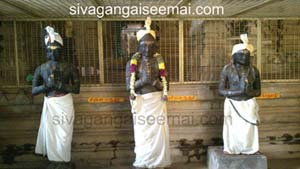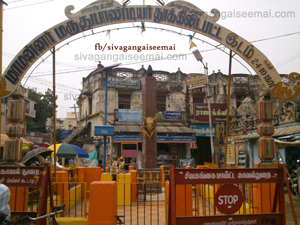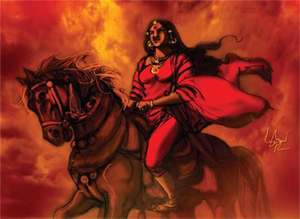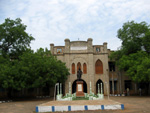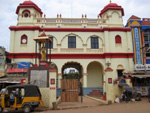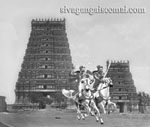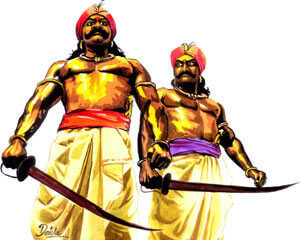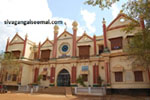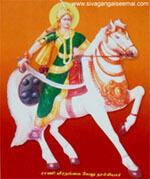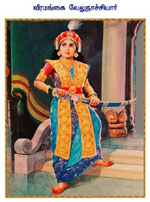FIRST RAJA OF SIVAGANGAI
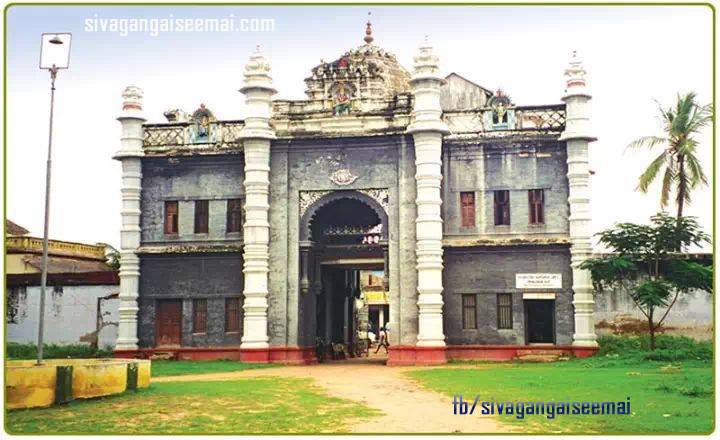
SASIVARNA PERIYA UDAYA THEVAR - (1730 -1750) (FIRST RAJAH OF SIVAGANGAI) (1730-1750)
The commission are aware, that the country now called Shevagunga was originally a part of the Ramnad Rauj; that Curta Taver, the Rajah of Ramnad, having divided the whole of his possessions into five, gave Shasavurna Taver two-fifth, reserving three fifths for him. A very general impression prevails in these countries, that Shasavurna Taver ( who in comparison with Curta Taver, was a man of considerable personal address) contrived to practise unfair means for his own advantage, with the sumperdies, who regulated the division. But this design of Shasavurna Taver, is understood to have extended to the capability of the portion he obtained, for future improvement, not to the actual past value of the Rauj, which was too well known to Curta Taver and his ministers, to render any collusion practicable. But on the other hand, are to be remembered the many advantages Ramnad has, since that time, received, in consequence of its maritime situation, from the progressive increase of its external commerce, and the permanent establishment of a large public investment of cloth, which consuming the whole of its manufactures, maintains a considered capital circulating in the country. Shevagunga participates but in a small degree/ in these advantages and hence the sale of its produce possesses not the same certainty and advantages, as Ramnad”.
Sivaganga king's hierarchy
Seshavurna Tevan took care to secure for himself at least as valuable a share as that of Kattaya Taven; and that he contented himself with two - fifths of the Ramnad country because the two-fifths which comprised his hereditary possessions were quite as productive as the whole of the remaining portion”. Sasivarna planned to divide Ramnad kingdom into two divisions - Three shares to the Sethupathy (Kattaya Thever) with the title of Maharajan meaning Great - king and his territory Great Seemai and two shares 2/5 to himself. Kattaya Thevar out of his gratitude to Sasivarna Thevar by whose acts of valour, he became the king of Ramanathapuram and also in view of the relationship between him and Sasivarna Thevar through the latter’s marriage with Sethupathy’s family agreed for the above division. The Tanjore king was also satisfied with the sharing of Ramnad by two persons in contrast to accumulation of power in one hand.
The new Sethupathi ordered the eldermen to measure and fix the territories. The kingdom was parcelled out into five parts. Sasivarna Thevar bribed the men who regulated the division and undervalued those taluks he desired to obtain. Kattaya Thevar retained three parts and ascended the Ramanathapuram throne with the title of “KUMARA MUTHU VIJAYA RAGHUNATHA SETHUPATHY”. The other two parts - Thirupathur and Sivagangai were given to Sasivarna Thevar. conferring on him the title of "RAJAH MUTHU VIJAYA RAGHUNATHA PERIYA UDAYA THEVAR”-6 The portion given to Sasivarna Thevar received the name of the palayam of Sivagangai. Sasivarna Thevar became the independent Raja of Sivagangai. He continued to retain the title of the poligar of Nalukottai. The Ramanathapuram region came to be known as "Peria Vadagai (Vattahai) or PERIYA MARAVAR NADU" and Sivagangai region as "Chinna Vadagai (Vattahai) or” Siria Maravar Nadu" or Nalukottai Seemai". In fact Ramanathapuram became less powerful than its child Sivagangai for the latter though smaller in size was more fertile by nature and with the advance of time the sterility of Ramanathapuram, the bigger province was not overcome while the fertility of the smaller was improved.
The above division took place in 1730 AD.-10 The Nawab being the supreme authority recognised the partition when it was informed to him by the new Sethupathy. The portion of territory acquired by Sasivarna Thevar received the name of Sivagangai which thenceforth became independent of Ramanathapuram though like other palayams it owed allegiance to the Nawab of the Carnatic."
SASIVARNA PERIYA UDAYA THEVAR (1730 – 1750)
Seshavurna Tevan took care to secure for himself at least as valuable a share as that of Kattaya Taven; and that he contented himself with two - fifths of the Ramnad country because the two-fifths which comprised his hereditary possessions were quite as productive as the whole of the remaining portion”. Sasivarna planned to divide Ramnad kingdom into two divisions - Three shares to the Sethupathy (Kattaya Thever) with the title of Maharajan meaning Great - king and his territory Great Seemai and two shares 2/5 to himself. Kattaya Thevar out of his gratitude to Sasivarna Thevar by whose acts of valour, he became the king of Ramanathapuram and also in view of the relationship between him and Sasivarna Thevar through the latter's marriage with Sethupathy's family agreed for the above division. The Tanjore king was also satisfied with the sharing of Ramnad by two persons in contrast to accumulation of power in one hand.
The new Sethupathi ordered the eldermen to measure and fix the territories. The kingdom was parcelled out into five parts. Sasivarna Thevar bribed the men who regulated the division and undervalued those taluks he desired to obtain. Kattaya Thevar retained three parts and ascended the Ramanathapuram throne with the title of "KUMARA MUTHU VIJAYA RAGHUNATHA SETHUPATHY”. The other two parts - Thirupathur and Sivagangai were given to Sasivarna Thevar. conferring on him the title of "RAJAH MUTHU VIJAYA RAGHUNATHA PERIYA UDAYA THEVAR”-6 The portion given to Sasivarna Thevar received the name of the palayam of Sivagangai. Sasivarna Thevar became the independent Raja of Sivagangai. He continued to retain the title of the poligar of Nalukottai. The Ramanathapuram region came to be known as "Peria Vadagai (Vattahai) or PERIYA MARAVAR NADU" and Sivagangai region as "Chinna Vadagai (Vattahai) or" Siria Maravar Nadu" or Nalukottai Seemai". In fact Ramanathapuram became less powerful than its child Sivagangai for the latter though smaller in size was more fertile by nature and with the advance of time the sterility of Ramanathapuram, the bigger province was not overcome while the fertility of the smaller was improved.
The above division took place in 1730 AD.-10 The Nawab being the supreme authority recognised the partition when it was informed to him by the new Sethupathy. The portion of territory acquired by Sasivarna Thevar received the name of Sivagangai which thenceforth became independent of Ramanathapuram though like other palayams it owed allegiance to the Nawab of the Carnatic."
A Translation of Malabar account narrates the order of succession in the Rameswaram or Sethupathy pollem and division of Ramnad into two as follows. A long time ago there lived at Pollur a Mara Man called Udayar. The man was at first Kavalkarar of Sethu (Rameswaram ) The travellers to Sethu having at that time been frequently insulted and plundered by colliers. Udayar collected some people and destroyed several of those robbers when he was thus clearing the road to Rameswaram, there came from the northward several leaders and Gosamigals people who pretended superior sanctity and on that account very much revered. There having seen his services took him a long with them to Pollur and gave him the Sethupattam - Rameswaram pollam under the authority of Urangapuly Thever. This is the origion of the Sethupathy Pollem. After Udayar’s death that country was governed by his son Kuthan Sethupathy. This man has a son by a vellalar woman who did not succeed his father but kuthan Sethupathy was succeeded by his brother - in-law called by some Dalavoy Sethupathy but his real name was Sadaika Devar. A war having been carried on as in Ramayana days, Sadaika Devar was taken prisoner and carried to Madurai where he was detained for some time as on his return after he was released he came to Mangal. He was assasinated by Madiyaralagan, great grand father to Sasivarna Thevar. After his death the country was divided into three parts. His son-in-law, Ramasuras, Sanyasia. Tirumalai Sethupathy obtained Ramanathapuram, his elder brother Tanakka Devar the Mangalakudi and Thambi Sethupathy son to the Kuthan Sethupathy by a vellala woman, the Kalayarkoil district by this three men the country was governed 16 years. But after the death of Thambi Sethupathy of Kalaiarkoil and Thanakka Devar of Mangalakudi, Thirumalai Sethupathy made himself master of all three provinces and governed them 16 years. His younger brother had 16 sons, the elder of Surya Thevar having heard that Tanjore Naick and Trichinoploly Karthakkal were at war, he went at first to the former. During his absence, his brother lived at Rameswaram, having heard that they intended to make themselves masters of the country, he left Tanjore and came to Rameswaram and after having murdered his 15 brothers and those who were with them, he returned to Tanjore but soon after the Trichnopoly people took him and put at Arandangi (P 1101) Thanda Devar one of his relatives succeeded to the Pollem. Bhavani Sanghu Thevar who had for some time lived at Tanjore returned with an army killed Tanda Thevar together with the Tondaiman’s sons who had assisted him and made himself master of the country which he governed four or five years. But, there lived at that time a defendant of Udayar Devar whose name was Sundareswara Devar. He was the great grand son of Madhiyaralagan who had associated with Sadaika Devar. He was the great grand son to Vengu Devar and son to Periya Udaya Devar. To him Vijaya Reghunatha Devar successor of Mugavai Uruni Ayya had given his daughter Aghilandeswari in marriage and given him likewise 6000 peons. This Sasivarna Dever dreading Bhavani Sankaran guilty escaped to Tanjore. Vijaya Regunatha Thevar’s aunt’s son Katta Dever, likewise for the same reason escaped to some other countries. Sasivarna Dever having killed a tiger at Tanjore obtained the Rajah’s favour who on that account (P 1102) sent an army with orders to deliver Bhavani Sanghu into Sasivarna Dever’s hands and gave him likewise the pollem. After the arrival of the Tanjore army, Katta Dever who had escaped to some country returned. The Tanjorians, after having taken and put to death Bhavani Sanghu, save the Ramamanathapuram country to Katta Dever and that of Sivaganga to Sasivarna Dever and after that they had divided these countries into five parts and given two parts to the one and the three parts to other. (SIC) Chanda Saheb was the son - in - law of Dost Ali, who succeeded Sadat -ul-lah as the Nawab of the Carnatic. Chanda Saheb interfered in the affairs of the Nayaks of Madurai. Minakshi, the Queen of Madurai purchased the support of Chanda sabeb for one crore of rupees. Accordingly Chanda Saheb was conducted by the Queen’s brother to a building on the banks of the Kaveri called the Dalavay - Mantapam, and then took a solemn oath to give over the kingdom to Minakshi in its entirety, and never to betray her interests in any the slightest degree.” Wilks says that this oath was taken upon a brick covered with a handsome cover and made to look like a Koran.-15 Under the command of Govindaiya and Ravanaiya, two of the Queen’s adherents, he sent a large army, consisting of 80,000 cavalry and some infantry, to the South to take possession of Dindigul, which was in the hands of Bangaru Tirumala, and conquer the whole country. Dindigul was stormed in a short time, and the army of Chanda Sahib marched to Madura. Bangaru Tirumala desperately collected a few troops to oppose the Invaders. In the battle of Ammaiya Nayakkanur, his army, which was strengthened by some poligars, made a bold stand, and fought a well contested battle, but was overpowered. 16 All the Nayak poligars around Madurai supported the cause of Bangaru Thirumalai. Sasivarna Thevar, the poligar of Sivagangai kept aloof. When defeated, Bangaru Thirumalai with his son Vijayakumara fled to the Sivagangai Country. Sasivarna Thevar could not tolerate the Nayakdom going under the Muslim rule. So he welcomed the two royal refugees who came to his country. He placed a number of villages at the disposal of the royal refugees and the fort of Vellikurichi belonging to him became the abode of Bangaru Thirumalai and Vijaya Kumara 17 Chanda Saheb did not chase them into the Sivaganga palayam because that would mean a war with the Maravas. Meanwhile Minakshi died and Chanda Saheb became the complete master of Thiruchirappalli. The Hindu rulers - the Marava rulers of Sivagangai and Ramanathapuram the Raja of Pudukottai, and the rulers of Pudukottai, and the ruler of Mysore joined together.18 They also called upon the Marathas for intervention. as they realised that Chanda Saheb was the agent of the Mughals. They wanted to restore Hindu rule in Madurai and decided to rethrone Bangaru. Sasivarna Thevar thought that the Mughal authority in Madurai was dangerous to his independence. So joining with the Sethupathy of Ramanathapuram he led in organising opposition to Chanda Saheb and sent despatches to the Hindu rulers. In 1739 at the invitation of Bangaru and Sayaji of Thanjavur 20 sent his generals. In May 1740 Shahu’s generals Raghuji Bhonsle and Fateh Singh descended upon the Carnatic in full force commanding forty thousand to fifty thousand horses.
A battle was fought as Damalcherri in A.D.1740 Dost Ali and his son Hasan Ali were killed in the battle. Safdar Alli, another son of Dost Ali frightened at the growing popularity of Chanda Saheb made a secret settlement with the Marathas. He promised to pay four lakhs of rupees for the suppression of Chanda Saheb. Suddenly in 1741, the Marathas appeared before the gates of Tiruchirappalli; Chanda Saheb and his son Abid Ali were taken prisoners by the Marathas. Sasivarna Thevar, the ruler of Sivagangai together with the Sethupathy and Tondaiman of Pudukkottai had raised five thousand soldiers and cavalry which numbered five thousand. The combined forces marched to Tiruchirappalli with the intentiion of making Bangaru as king. But the Marathas appointed Murari Rao as their Governor. They promised the Maravas that their independent status would be maintained. The Poligar of Sivagangai was not satisfied with this but he had to keep silent because he was not ready to wage a war with the Marathas. Also he waited for the complete extinction of Muslim menace Murari Rao, the Maratha nominee establised cordial relations with Sasivarna Thevar of Sivgangai and the other Maravas. After the death of dost Ali, his son Safdar Ali acted as the Nawab. In 1742 Safder Ali was killed in cold blood in vellore by his cousin Murtaza Ali
Murtaza Ali crowned himself the Nawab. When the soldiers were not paid the arrears of payments they turned riotous and Murtaza fled to Arcot. Syed Muhammad, the infant son of Safdar Ali. who was in the protection of the English in Madras was proclaimed the Nawab with the name Sadat-ul-lah Khan-II. Anwar - ud-din who was appointed as the guardian became the Nawab. When a pathan who had a private grievance with the prince killed him. Thus the line of the Wallajahs started. Bangaru who was given false hopes by Anwar-ud-din was poisoned. His son Vijayakumara escaped to Vellikurichi in Sivagangai. He was again well received by Sasivarna Thevar, the ruler of Sivagangai. Sasivarna Thevar assured him that he would be reinstated at Madurai. In 1744 Maphuz Khan, the eldest son of Anwar-ud-din was sent to punish the Marava rulers of Sivagangai and Ramanathapuram and the other poligars who allied with the Nayaks. When he failed, Muhammed Ali was sent. Muhammad Ali routed many, levied contributions and took several of them prisoners. But unfortunately on his way back, the Kallars looted his camp and he had a narrow escape. The defeated poligars regained their Independence. Muhammad Ali did not take any immediate steps to subdue the Maravas.
When Raja Pratap Singh, the Maratha ruler of Thanjavur invaded the territory of the Maravas, Muhammad Ali went on a relief expedition.29 But this help rendered to the Maravas did not gain any benefit for the Wallajahs. The growing influence of the Wallajahs frightened the local powers. Soon Sasivarna Thevar consulted with the Marava ruler of Ramanathapuram, the ruler of Thanjavur and several other Poligars. They drew closer and conspired against the Wallajahs. The conspirators made a settlement with the King of Mysore. They decided to conquer Tiruchirapplli and restore the Nayaks to the throne. But they could not take any action shortly after the first Carnatic War started. Anwar-ud-din because of his engagements in the Carnatic paid little attention on the Maravas. The Maravas also had to face internal confusion. So they did not come into any clash for a short while. With the entry of Chanda Saheb the political scene became alert. He was released by the Marathas. He began to claim the throne of Arcot. He secured the support of the Muzaffar Jung. He also got military aid from the French. Assisted, by Muzaffar Jung and the French, he defeated Anwar - ud-din at the battle of Ambur on the 23rd of July 1749. Anwar -ud-din lost his life in the battle. Maphuz Khan was taken prisoner, but Muhammad Ali managed to escape. Since Arcot was lost to Chanda Saheb who styled himself Nawab of Arcot. Muhammad Ali retired to Tiruchirappalli. He assumed the title of Nawab of Arcot. Chanda Saheb chased Muhammad Ali. At this critical juncture, Muhammad Ali requested the Maravas for aid. They sent an army but it never went into action. The Palayam of Sivagangai maintained its Independent status. Sasivarna Thevar the ruler of the state was still protecting Vijayakumara. Though he pretended to support Muhammad Ali, he did not actually participate in the conflict. He was a silent spectator and he followed a policy of non-intervention. He breathed his lost in A.D.1750 In 1750 Sasivarna Thevar created a new capital at Sivagangai. At that time Father BERTOLDI came on a visit to Sivagangai and was received with royal honours. Thereafter the king permitted the missionaries to preach and build churches in his kingdom.
Quick Links
Maruthupandiyar History in English
Read Maruthupandiyar History in English...
Maruthu Pandiyar History in Tamil
Read Maruthupandiyar History in Tamil...
Velu Nachiyar History in Tamil
Velu Nachiyar History in Tamil...
Sivagangai Palace
Sivagangai Palace photo gallery to view Read More ......
Sivagangai Car Festival
Sivaganga Photo Gallery
2008 - www.sivagangaiseemai.com
ALL Rights Reserved. Privacy Policy

